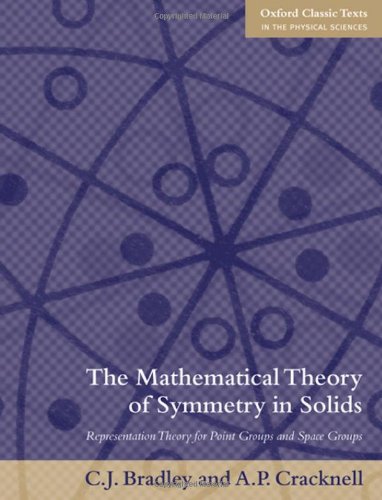Mathematical Theory of Symmetry in Solids: Representation Theory for Point Groups and Space Groups download
Par castillo josephine le vendredi, juin 19 2015, 13:02 - Lien permanent
Mathematical Theory of Symmetry in Solids: Representation Theory for Point Groups and Space Groups. A.P. Cracknell, C.J. Bradley

Mathematical.Theory.of.Symmetry.in.Solids.Representation.Theory.for.Point.Groups.and.Space.Groups.pdf
ISBN: 0198519206, | 755 pages | 19 Mb

Mathematical Theory of Symmetry in Solids: Representation Theory for Point Groups and Space Groups A.P. Cracknell, C.J. Bradley
Publisher: Oxford University Press
The Mathematical Theory of Symmetry in Solids: Representation Theory for Point Groups and Space Groups (Oxford Classic Texts in the Physical Sciences) - Oxford Univ Pr (Txt) - ecs4.com. The symmetries of solid matter form a subset of the symmetries of liquid matter which form a subset of the symmetries of gaseous matter which form a subset of the symmetries of plasma. Dawid is a particle theorist turned philosopher, and as you might guess from the endorsement, he approaches string theory from an enthusiast's point of view. In other words, for G a Lie group, Chern-Simons theory is a sigma-model TQFT whose target space is the smooth moduli stack B G conn of G -principal connections, and whose background gauge field is a circle 3-bundle with connection on B G . The fundamental question That group represents a slight majority of physicists in theoretical high energy physics today. I will talk about linear representations only. From a modern point of view, the mathematical model for a gauge field in physics is a cocycle in (nonabelian) differential cohomology: a principal bundle with connection and its higher analogs. Generosity within a Communal Sharing group is not usually conceived of as altruism due to this shared identity, even though there is typically much behavior which otherwise would seem like extreme altruism. Mathematical Theory of Symmetry in Solids: Representation Theory for Point Groups and Space Groups. Theory are defined on 3-dimensional manifolds Σ with a closed 1-dimensional submanifold Σ def ↪ Σ where each connected component (diffeomorphic to a circle) is labeled by an ireeducible unitary representation R i of the gauge group. More fun starts when we consider representations. The ICGTPM series is traditionally dedicated to the application of symmetry and group theoretical methods in physics, chemistry and mathematics, and to the development of mathematical tools and theories for progress in group theory belonged to two important communities: on the one hand, solid state specialists, elementary particle theorists and phenomenologists, and on the other, mathematicians eager to apply newly-discovered group and algebraic structures. Based on an internal String theory thus should not be taken to announce an end of science but rather to represent a new phase of scientific progress.